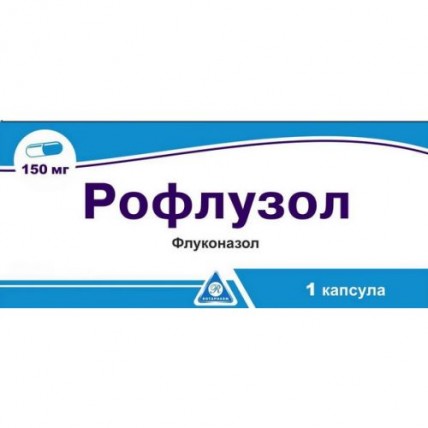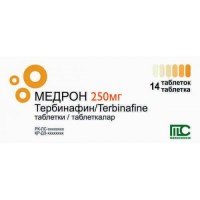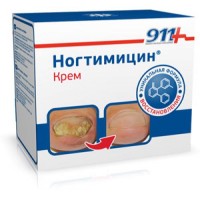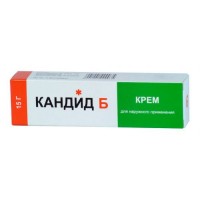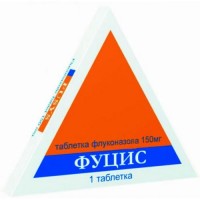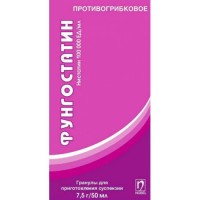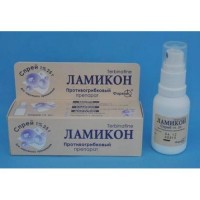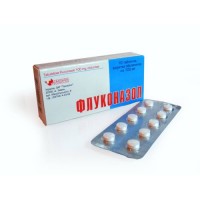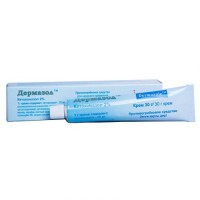Rofluzol 1's 150 mg capsule
- $15.20
The instruction for medical use
of ROFLUZOL medicine
the Trade name
Rofluzol
Mezhdunarodnoye the unlicensed
name Flukonazol Lekarstvennaya a form
of the Capsule of 50 mg and 150 mg
Structure
One capsule contains
active agent: flukonazol 50 mg and 150 mg,
excipients: microcrystalline cellulose, talc, magnesium stearate,
structure of a cover: the titan dioxide (E171), an azoruby (E122), diamond blue (E133), diamond black PN (E151), gelatin, methylparahydroxybenzoate, propilparagidroksibenzoat (for a dosage of 50 mg),
structure of a cover:
the cover - the titan dioxide (E171), an azoruby (E122), diamond blue (E133), diamond black PN (E151), methylparahydroxybenzoate, propilparagidroksibenzoat, gelatin,
the body - the titan dioxide (E171), an azoruby (E122), ponso 4R (E124), diamond blue (E133), sanst yellow (E110), methylparahydroxybenzoate, propilparagidroksibenzoat, gelatin
the Description
Solid gelatin capsules 4 of No. in size, with the opaque body of pink color and an opaque cover of blue color (for a dosage of 50 mg).
Solid gelatin capsules 1 of No. in size, with the opaque body of orange color and an opaque cover of blue color (for a dosage of 150 mg).
Contents of capsules – powder of white or almost white color.
Pharmacotherapeutic group
Antifungal drugs for system use, triazole derivatives. Flukonazol
the ATX J02AC01 Code
the Pharmacological
Pharmacokinetics Drug properties is quickly soaked up from a GIT and is rather full (food does not influence absorption speed), bioavailability - 90%. The maximum concentration is reached in 0.5-1.5 h after reception on an empty stomach.
Linking with proteins of plasma - 11-12%. Well gets into all liquids of an organism. Concentration of active agent in breast milk, articulate liquid, saliva, a phlegm and peritoneal liquid are similar to that in blood plasma. Constant values in a vaginal secret are reached in 8 h after intake and keep at this level not less than 24 h. In fungal meningitis the concentration in cerebrospinal fluid makes about 80% of that in plasma. In secretion of sweat glands, epidermis and in a corneal layer the concentration exceeding serumal (selection accumulation) are reached.
80% in not changed look are removed by kidneys, the rest - in the form of metabolites. The circulating metabolites are not found. Elimination half-life makes about 30 h.
The pharmacokinetics of a flukonazol significantly depends on function of kidneys, at the same time there is an inversely proportional dependence between time of semi-removal and clearance of creatinine. After a hemodialysis during 3 h the concentration in blood plasma of a flukonazol decreases by 50%.
A pharmacodynamics
Rofluzol - antifungal means of group of triazole. Flukonazol - active agent of drug - is powerful selection inhibitor of synthesis of sterols in cell membranes of mushrooms. The mechanism of action is caused by P450 cytochrome blockade. Flukonazol blocks transformation of a lanosterol of cells of mushrooms into ergosterol, increases permeability of a cellular membrane, breaks its growth and replication. Being high-selective for P450 cytochrome of mushrooms, practically does not oppress these enzymes in a human body (in comparison with itrakonazoly, Clotrimazolum, econazoly and ketokonazoly to a lesser extent suppresses oxidizing processes, dependent on P450 cytochrome, in microsomes of a liver of the person). Has no antiadrogenny activity.
It is active in the opportunistic mycoses including caused by Candida spp. (including generalized forms of candidiasis against the background of an immunosuppression), Cryptococcus neoformans and Coccidioides immitis (including intracranial infections), Microsporum spp. and Trichophyton spp., in the endemic mycoses caused by Blastomyces dermatidis, Histoplasma capsulatum (including at an immunosuppression). For prevention of fungal infections at patients with malignant new growths at treatment with their cytostatics or performing radiation therapy, at organ transplantation and in other cases when the immunity is suppressed and is available danger of development of a fungal infection.
Indications
- genital candidiasis
- acute or recurrent vaginal candidiasis
- prevention for the purpose of reduction of frequency of a recurrence of vaginal candidiasis (3 and more episodes a year)
- a candidosis balanitis
- candidiasis of mucous membranes, including mucous membranes of a mouth and throat, a gullet, noninvasive bronchopulmonary infections, a kandiduriya, the skin and mucous and chronic atrophic candidiasis of an oral cavity (connected with carrying dentures)
- prevention of a recurrence of oropharyngeal candidiasis at patients with AIDS
- generalized candidiasis, including a kandidemiya, disseminate candidiasis and other forms of an invasive candidosis infection (including infections of a peritoneum, endocardium, eyes, respiratory and uric ways). Treatment can be carried out at patients with malignant new growths, sick intensive care units, the patients receiving cytotoxic or immunosuppressive means and also in the presence of other factors contributing ment of candidiasis.
- a cryptococcosis, including cryptococcal meningitis and infections of other localization (for example, lungs, skin)
- prevention of fungal infections at the patients with malignant tumors predisposed ment of such infections as a result of cytotoxic chemotherapy or radiation therapy
- skin mycoses, including mycoses of feet, bodies, inguinal area, a chromophytosis, onychomycoses and skin candidosis infections
- deep endemic mycoses at patients with normal immunity, a coccidioidomycosis, a paracoccidioidomycosis, a sporotrichosis and histoplasmosis.
A route of administration and doses
of the Capsule for intake.
The daily dose of Rofluzol depends on character and weight of a fungal infection.
The Rofluzol capsules are swallowed entirely, irrespective of meal.
Adults:
Vaginal candidiasis: 150 mg once inside.
Prevention of a recurrence of vaginal candidiasis: 150 mg once a month. Duration of therapy is determined individually, it varies from 4 to 12 months. More frequent use can be required by some patients.
The balanitis caused by Candida: 150 mg once inside.
In extragenital candidiasis, for example in an esophagitis, noninvasive bronchopulmonary damage, a kandiduriya, candidiasis of skin and mucous membranes, etc.: the effective dose usually makes 50-100 mg in day lasting treatment of 14-30 days. For prevention of a recurrence of oropharyngeal candidiasis at patients about AIDS after end of a full course of primary therapy drug can be appointed on 150 mg once a week.
Ezofagealny candidiasis: in the first day the recommended dose of 200 mg, in the next days 100 mg of 1 times a day, a course of treatment of 7-14 days.
Orofaringealny candidiasis: a daily dose of drug - 50-100 mg of 1 times a day, a course of treatment of 7-14 days. If necessary, at patients with the significant decrease in immunity, treatment can
be longer.
Atrophic candidiasis of an oral cavity against the background of carrying dentures: 50 mg a day in combination with local antiseptic therapy within 14 days.
Generalized candidiasis, including a kandidemiya, disseminate candidiasis and other forms of an invasive candidosis infection: 400 mg in the first day of therapy, then - on 200 mg a day. At insufficient clinical performance the dose of drug can be increased up to 400 mg a day. Duration of therapy depends on clinical performance.
Prevention of a recurrence of candidiasis against the background of an immunodeficiency. For prevention of candidiasis the recommended dose of a flukonazol makes 50-400 mg of 1 times a day depending on degree of risk of developing a fungal infection. With high risk of a generalized infection, for example at patients from the expected expressed or it is long the remaining neutropenia, the recommended dose makes 400 mg of 1 times a day. Flukonazol appoint some days before the expected emergence of a neutropenia, after increase in number of neutrophils more 1000/mkl continue treatment within 7 days.
Cryptococcal meningitis and cryptococcal infections of other localization: in the first day – on average 400 mg, and then – 200 mg of 1 times a day. Treatment has to continue within 10-12 weeks after confirmation of sterility of cerebrospinal fluid. For prevention of a recurrence of cryptococcal meningitis at patients with AIDS after end of a full course of primary treatment, the recommended dosage of 200 mg a day.
Skin infections (including mycoses of feet, smooth skin, inguinal area and candidosis infections): 150 mg once a week or 50 mg a day, a course of treatment - 2-4 weeks, in mycosis of feet - up to 6 weeks.
Chromophytosis: 50 mg a day within 2-4 weeks or 300 mg once a week within 2 weeks.
Onychomycoses: 150 mg once a week. The course of treatment proceeds before full substitution of the affected nail healthy. Repeated growth of nails on fingers of hands and feet normal requires 3-6 months and 6-12 months respectively.
Deep endemic mycoses: in deep endemic mycoses the use of drug in a dose of 200-400 mg a day during up to 2 years can be required. Duration of therapy is determined individually: in a coccidioidomycosis - 11-24 months, in a paracoccidioidomycosis - 2-17 months, in a sporotrichosis - 1-16 months, in histoplasmosis - 3-17 months.
At patients of advanced age in the absence of renal failures Rofluzol apply according to the usual mode of dosing.
Use of a flukonazol in a renal failure:
At single use of drug of dose adjustment it is not required.
At course treatment the first (shock) dose makes from 50 to 300 mg. Then the dose of drug or frequency of use need to be changed depending on clearance of creatinine, namely:
The clearance of creatinine of ml/min.
the Dosage
& gt, the 50th
dose of drug does not change
11 - 50
each 24 hours a half of a usual daily dose
At regularly carried out dialysis:
a usual daily dose after each procedure
Side effects
Often
- a headache
- an abdominal pain, diarrhea, nausea, vomiting
- increase in level of alkaline phosphatase, serumal level of aminotransferases (ALT and nuclear heating plant)
- rash
Infrequently
- insomnia, drowsiness
- spasms, dizziness, paresthesia, change of taste
- vertigo
- dyspepsia, a meteorism, dryness in a mouth
- a cholestasia, jaundice, the raised bilirubin
- an itching, urticaria, the increased sweating, the dermatitis caused by effect of medicine
- myalgia
- fatigue, an indisposition, weakness, fervescence
Is rare
- an agranulocytosis, a leukopenia, a neutropenia, thrombocytopenia
- an anaphylaxis, a Quincke's disease
- a gipertriglitseridemiya, a giperkholesteramiya, a hypopotassemia
- a tremor
- blinking/trembling of ventricles, increase in an interval of QT
- hepatotoxicity, including exceptional cases with a lethal outcome, the liver failure, hepatocellular necrosis, hepatocellular damages
- a toxic epidermal necrolysis, Stephens-Johnson's syndrome, sharp generalized exanthematous pustulez, exfoliative dermatitis, a face edema, an alopecia
At patients with AIDS or cancer, at treatment by Rofluzol and similar drugs were observed changes of indicators of blood, function of kidneys and a liver, however clinical values of these changes and their communication with treatment are not established.
Contraindications
- hypersensitivity to a flukonazol, other components of drug or azolny substances with similar to a flukonazol structure
- a concomitant use of a terfenadin during repeated use of Rofluzol in a dose of 400 mg/days and more
- a concomitant use of the medicines extending an interval of QT and which are metabolized by means of CYP3A4 enzyme, such as tsizaprid, astemizol, erythromycin, Pimozidum and quinine
- pregnancy and a lactation
- children's age up to 18 years
Medicinal interactions
Flukonazol strengthens pharmacological effect of antihistamines (astemizol, terfenadin), the anxiolytics relating to group of benzodiazepines of the short period of action (midazolam, to triazoles), a rifabutina, the tsizaprida, Phenytoinum, a zidovudine, a takrolimus, cyclosporine, extends elimination half-life of theophylline and increases risk of developing intoxication that demands correction of its dose.
Hydrochlorthiazidum increases the level of concentration of a flukonazol in plasma, at a concomitant use with rifampicin the decrease in elimination half-life of a flukonazol from blood plasma is noted.
Flukonazol increases concentration level in blood plasma and also increases elimination half-life of oral gipoglikemiziruyushchy medicines – sulphonylurea derivatives (glibenclamide, glipizid, tolbutamide). At simultaneous use of these medicines it is necessary to control more carefully blood sugar level for prevention of development of a hypoglycemia.
At simultaneous use of a flukonazol with oral contraceptive medicines the fluctuation of level of concentration of hormones (oestradiol, levonorgestrel) is possible, at a concomitant use of these medicines it is necessary to carry out more careful control of a condition of patients for prevention of development of possible collateral symptoms.
The efficiency of coumarinic anticoagulants raises, increase in a prothrombin time in this connection development of bleedings is possible is possible (hematomas, bleedings from a nose and a GIT, a hamaturia, a melena).
At co-administration of a flukonazol and Amphotericinum B it is necessary to consider the antagonistic nature of their interaction, however, in practice the result of interaction is defined by what substance was entered earlier and a type of a pathogenic fungus.
Special instructions
In rare instances Rofluzol's use was followed by toxic changes of a liver, including with a lethal outcome, mainly at patients with associated diseases. Hepatotoxic action of Rofluzol usually was reversible, his signs disappeared after the therapy termination. Patients at whom during treatment by Rofluzol indicators of function of a liver are broken need to be observed for the purpose of identification of signs of damage of a liver. At emergence of clinical signs or symptoms of damage of a liver which can be connected with Rofluzol's use, drug should be cancelled.
Rofluzol in rare instances can cause anaphylactic reactions.
During treatment by Rofluzol at patients exfoliative skin reactions, such as Stephens-Johnson's syndrome and toxic epidermal necrolysis in rare instances developed. Patients with AIDS are more inclined ment of heavy skin reactions at use of many drugs. At emergence in the patient during treatment of a superficial fungal infection of rash which can be connected with Rofluzol's use, drug should be cancelled. At appearance of rash in patients with their invasive/system fungal infections it is necessary to observe and cancel carefully Rofluzol at emergence of bullous defeats or a mnogoformny erythema.
Rofluzol can cause increase in an interval of QT at the ECG. At Rofluzol's use the increase in an interval of QT and blinking/trembling of ventricles noted very seldom at patients with multiple factors of risk, such as organic heart diseases, disturbances of electrolytic balance and the accompanying therapy contributing to the development of similar disturbances. Therefore such patients with potentially pro-arrhythmic states should apply Rofluzol with care.
Patients with diseases of a liver, heart and kidneys before Rofluzol's use are recommended to consult with the doctor. At Rofluzol's use 150 mg concerning vaginal candidiasis the patients have to be warned that improvement of symptoms is usually observed in 24 h, but their total disappearance sometimes requires several days. At preservation of symptoms within several days, it is necessary to see a doctor.
The feature of influence of medicine on ability to run the vehicle or potentially dangerous mechanisms
Should be careful when driving or using of the equipment as there can be dizziness or spasms.
Overdose
Symptoms: nausea, vomiting, diarrhea, in more hard cases - spasms.
Treatment: symptomatic. Gastric lavage, artificial diuresis. The hemodialysis during 3 h reduces concentration in plasma approximately by 50%.
A form of release and packing
On 7 capsules (for a dosage of 50 mg) or 1 capsule (for a dosage of 150 mg) in blister strip packaging from a film of polyvinylchloride and aluminum foil.
On 1 planimetric packing together with the instruction for medical use in the state and Russian languages put in a pack from cardboard.
To Store storage conditions at a temperature not over 25º C.
To store out of children's reach!
4 years
not to apply a period of storage after an expiration date.
Prescription status
According to the prescription
the Producer
"K.O. Slaviya of Pharmaceutical S.R. L. ", Boulevard Theodor Palladi No. 44C, sector 3, Bucharest, Romania
("S.C. Slavia Pharm S.R.L.", Bd. Theodor Pallady no. 44C, district 3, Bucharest, Romania).
The owner of a trademark and the certificate of registration is
the ROTAFARM LIMITED company, GREAT BRITAIN
the Owner of the registration certificate of ROTAFARM LIMITED, GREAT BRITAIN
the Address of the organization accepting in the territory of the Republic of Kazakhstan claims from consumers on quality produktsiirk Almaty, Turksibsky district, Suyunbaya Ave., 222btel/fax: 8 (7272) 529090
of ROFLUZOL medicine
the Trade name
Rofluzol
Mezhdunarodnoye the unlicensed
name Flukonazol Lekarstvennaya a form
of the Capsule of 50 mg and 150 mg
Structure
One capsule contains
active agent: flukonazol 50 mg and 150 mg,
excipients: microcrystalline cellulose, talc, magnesium stearate,
structure of a cover: the titan dioxide (E171), an azoruby (E122), diamond blue (E133), diamond black PN (E151), gelatin, methylparahydroxybenzoate, propilparagidroksibenzoat (for a dosage of 50 mg),
structure of a cover:
the cover - the titan dioxide (E171), an azoruby (E122), diamond blue (E133), diamond black PN (E151), methylparahydroxybenzoate, propilparagidroksibenzoat, gelatin,
the body - the titan dioxide (E171), an azoruby (E122), ponso 4R (E124), diamond blue (E133), sanst yellow (E110), methylparahydroxybenzoate, propilparagidroksibenzoat, gelatin
the Description
Solid gelatin capsules 4 of No. in size, with the opaque body of pink color and an opaque cover of blue color (for a dosage of 50 mg).
Solid gelatin capsules 1 of No. in size, with the opaque body of orange color and an opaque cover of blue color (for a dosage of 150 mg).
Contents of capsules – powder of white or almost white color.
Pharmacotherapeutic group
Antifungal drugs for system use, triazole derivatives. Flukonazol
the ATX J02AC01 Code
the Pharmacological
Pharmacokinetics Drug properties is quickly soaked up from a GIT and is rather full (food does not influence absorption speed), bioavailability - 90%. The maximum concentration is reached in 0.5-1.5 h after reception on an empty stomach.
Linking with proteins of plasma - 11-12%. Well gets into all liquids of an organism. Concentration of active agent in breast milk, articulate liquid, saliva, a phlegm and peritoneal liquid are similar to that in blood plasma. Constant values in a vaginal secret are reached in 8 h after intake and keep at this level not less than 24 h. In fungal meningitis the concentration in cerebrospinal fluid makes about 80% of that in plasma. In secretion of sweat glands, epidermis and in a corneal layer the concentration exceeding serumal (selection accumulation) are reached.
80% in not changed look are removed by kidneys, the rest - in the form of metabolites. The circulating metabolites are not found. Elimination half-life makes about 30 h.
The pharmacokinetics of a flukonazol significantly depends on function of kidneys, at the same time there is an inversely proportional dependence between time of semi-removal and clearance of creatinine. After a hemodialysis during 3 h the concentration in blood plasma of a flukonazol decreases by 50%.
A pharmacodynamics
Rofluzol - antifungal means of group of triazole. Flukonazol - active agent of drug - is powerful selection inhibitor of synthesis of sterols in cell membranes of mushrooms. The mechanism of action is caused by P450 cytochrome blockade. Flukonazol blocks transformation of a lanosterol of cells of mushrooms into ergosterol, increases permeability of a cellular membrane, breaks its growth and replication. Being high-selective for P450 cytochrome of mushrooms, practically does not oppress these enzymes in a human body (in comparison with itrakonazoly, Clotrimazolum, econazoly and ketokonazoly to a lesser extent suppresses oxidizing processes, dependent on P450 cytochrome, in microsomes of a liver of the person). Has no antiadrogenny activity.
It is active in the opportunistic mycoses including caused by Candida spp. (including generalized forms of candidiasis against the background of an immunosuppression), Cryptococcus neoformans and Coccidioides immitis (including intracranial infections), Microsporum spp. and Trichophyton spp., in the endemic mycoses caused by Blastomyces dermatidis, Histoplasma capsulatum (including at an immunosuppression). For prevention of fungal infections at patients with malignant new growths at treatment with their cytostatics or performing radiation therapy, at organ transplantation and in other cases when the immunity is suppressed and is available danger of development of a fungal infection.
Indications
- genital candidiasis
- acute or recurrent vaginal candidiasis
- prevention for the purpose of reduction of frequency of a recurrence of vaginal candidiasis (3 and more episodes a year)
- a candidosis balanitis
- candidiasis of mucous membranes, including mucous membranes of a mouth and throat, a gullet, noninvasive bronchopulmonary infections, a kandiduriya, the skin and mucous and chronic atrophic candidiasis of an oral cavity (connected with carrying dentures)
- prevention of a recurrence of oropharyngeal candidiasis at patients with AIDS
- generalized candidiasis, including a kandidemiya, disseminate candidiasis and other forms of an invasive candidosis infection (including infections of a peritoneum, endocardium, eyes, respiratory and uric ways). Treatment can be carried out at patients with malignant new growths, sick intensive care units, the patients receiving cytotoxic or immunosuppressive means and also in the presence of other factors contributing ment of candidiasis.
- a cryptococcosis, including cryptococcal meningitis and infections of other localization (for example, lungs, skin)
- prevention of fungal infections at the patients with malignant tumors predisposed ment of such infections as a result of cytotoxic chemotherapy or radiation therapy
- skin mycoses, including mycoses of feet, bodies, inguinal area, a chromophytosis, onychomycoses and skin candidosis infections
- deep endemic mycoses at patients with normal immunity, a coccidioidomycosis, a paracoccidioidomycosis, a sporotrichosis and histoplasmosis.
A route of administration and doses
of the Capsule for intake.
The daily dose of Rofluzol depends on character and weight of a fungal infection.
The Rofluzol capsules are swallowed entirely, irrespective of meal.
Adults:
Vaginal candidiasis: 150 mg once inside.
Prevention of a recurrence of vaginal candidiasis: 150 mg once a month. Duration of therapy is determined individually, it varies from 4 to 12 months. More frequent use can be required by some patients.
The balanitis caused by Candida: 150 mg once inside.
In extragenital candidiasis, for example in an esophagitis, noninvasive bronchopulmonary damage, a kandiduriya, candidiasis of skin and mucous membranes, etc.: the effective dose usually makes 50-100 mg in day lasting treatment of 14-30 days. For prevention of a recurrence of oropharyngeal candidiasis at patients about AIDS after end of a full course of primary therapy drug can be appointed on 150 mg once a week.
Ezofagealny candidiasis: in the first day the recommended dose of 200 mg, in the next days 100 mg of 1 times a day, a course of treatment of 7-14 days.
Orofaringealny candidiasis: a daily dose of drug - 50-100 mg of 1 times a day, a course of treatment of 7-14 days. If necessary, at patients with the significant decrease in immunity, treatment can
be longer.
Atrophic candidiasis of an oral cavity against the background of carrying dentures: 50 mg a day in combination with local antiseptic therapy within 14 days.
Generalized candidiasis, including a kandidemiya, disseminate candidiasis and other forms of an invasive candidosis infection: 400 mg in the first day of therapy, then - on 200 mg a day. At insufficient clinical performance the dose of drug can be increased up to 400 mg a day. Duration of therapy depends on clinical performance.
Prevention of a recurrence of candidiasis against the background of an immunodeficiency. For prevention of candidiasis the recommended dose of a flukonazol makes 50-400 mg of 1 times a day depending on degree of risk of developing a fungal infection. With high risk of a generalized infection, for example at patients from the expected expressed or it is long the remaining neutropenia, the recommended dose makes 400 mg of 1 times a day. Flukonazol appoint some days before the expected emergence of a neutropenia, after increase in number of neutrophils more 1000/mkl continue treatment within 7 days.
Cryptococcal meningitis and cryptococcal infections of other localization: in the first day – on average 400 mg, and then – 200 mg of 1 times a day. Treatment has to continue within 10-12 weeks after confirmation of sterility of cerebrospinal fluid. For prevention of a recurrence of cryptococcal meningitis at patients with AIDS after end of a full course of primary treatment, the recommended dosage of 200 mg a day.
Skin infections (including mycoses of feet, smooth skin, inguinal area and candidosis infections): 150 mg once a week or 50 mg a day, a course of treatment - 2-4 weeks, in mycosis of feet - up to 6 weeks.
Chromophytosis: 50 mg a day within 2-4 weeks or 300 mg once a week within 2 weeks.
Onychomycoses: 150 mg once a week. The course of treatment proceeds before full substitution of the affected nail healthy. Repeated growth of nails on fingers of hands and feet normal requires 3-6 months and 6-12 months respectively.
Deep endemic mycoses: in deep endemic mycoses the use of drug in a dose of 200-400 mg a day during up to 2 years can be required. Duration of therapy is determined individually: in a coccidioidomycosis - 11-24 months, in a paracoccidioidomycosis - 2-17 months, in a sporotrichosis - 1-16 months, in histoplasmosis - 3-17 months.
At patients of advanced age in the absence of renal failures Rofluzol apply according to the usual mode of dosing.
Use of a flukonazol in a renal failure:
At single use of drug of dose adjustment it is not required.
At course treatment the first (shock) dose makes from 50 to 300 mg. Then the dose of drug or frequency of use need to be changed depending on clearance of creatinine, namely:
The clearance of creatinine of ml/min.
the Dosage
& gt, the 50th
dose of drug does not change
11 - 50
each 24 hours a half of a usual daily dose
At regularly carried out dialysis:
a usual daily dose after each procedure
Side effects
Often
- a headache
- an abdominal pain, diarrhea, nausea, vomiting
- increase in level of alkaline phosphatase, serumal level of aminotransferases (ALT and nuclear heating plant)
- rash
Infrequently
- insomnia, drowsiness
- spasms, dizziness, paresthesia, change of taste
- vertigo
- dyspepsia, a meteorism, dryness in a mouth
- a cholestasia, jaundice, the raised bilirubin
- an itching, urticaria, the increased sweating, the dermatitis caused by effect of medicine
- myalgia
- fatigue, an indisposition, weakness, fervescence
Is rare
- an agranulocytosis, a leukopenia, a neutropenia, thrombocytopenia
- an anaphylaxis, a Quincke's disease
- a gipertriglitseridemiya, a giperkholesteramiya, a hypopotassemia
- a tremor
- blinking/trembling of ventricles, increase in an interval of QT
- hepatotoxicity, including exceptional cases with a lethal outcome, the liver failure, hepatocellular necrosis, hepatocellular damages
- a toxic epidermal necrolysis, Stephens-Johnson's syndrome, sharp generalized exanthematous pustulez, exfoliative dermatitis, a face edema, an alopecia
At patients with AIDS or cancer, at treatment by Rofluzol and similar drugs were observed changes of indicators of blood, function of kidneys and a liver, however clinical values of these changes and their communication with treatment are not established.
Contraindications
- hypersensitivity to a flukonazol, other components of drug or azolny substances with similar to a flukonazol structure
- a concomitant use of a terfenadin during repeated use of Rofluzol in a dose of 400 mg/days and more
- a concomitant use of the medicines extending an interval of QT and which are metabolized by means of CYP3A4 enzyme, such as tsizaprid, astemizol, erythromycin, Pimozidum and quinine
- pregnancy and a lactation
- children's age up to 18 years
Medicinal interactions
Flukonazol strengthens pharmacological effect of antihistamines (astemizol, terfenadin), the anxiolytics relating to group of benzodiazepines of the short period of action (midazolam, to triazoles), a rifabutina, the tsizaprida, Phenytoinum, a zidovudine, a takrolimus, cyclosporine, extends elimination half-life of theophylline and increases risk of developing intoxication that demands correction of its dose.
Hydrochlorthiazidum increases the level of concentration of a flukonazol in plasma, at a concomitant use with rifampicin the decrease in elimination half-life of a flukonazol from blood plasma is noted.
Flukonazol increases concentration level in blood plasma and also increases elimination half-life of oral gipoglikemiziruyushchy medicines – sulphonylurea derivatives (glibenclamide, glipizid, tolbutamide). At simultaneous use of these medicines it is necessary to control more carefully blood sugar level for prevention of development of a hypoglycemia.
At simultaneous use of a flukonazol with oral contraceptive medicines the fluctuation of level of concentration of hormones (oestradiol, levonorgestrel) is possible, at a concomitant use of these medicines it is necessary to carry out more careful control of a condition of patients for prevention of development of possible collateral symptoms.
The efficiency of coumarinic anticoagulants raises, increase in a prothrombin time in this connection development of bleedings is possible is possible (hematomas, bleedings from a nose and a GIT, a hamaturia, a melena).
At co-administration of a flukonazol and Amphotericinum B it is necessary to consider the antagonistic nature of their interaction, however, in practice the result of interaction is defined by what substance was entered earlier and a type of a pathogenic fungus.
Special instructions
In rare instances Rofluzol's use was followed by toxic changes of a liver, including with a lethal outcome, mainly at patients with associated diseases. Hepatotoxic action of Rofluzol usually was reversible, his signs disappeared after the therapy termination. Patients at whom during treatment by Rofluzol indicators of function of a liver are broken need to be observed for the purpose of identification of signs of damage of a liver. At emergence of clinical signs or symptoms of damage of a liver which can be connected with Rofluzol's use, drug should be cancelled.
Rofluzol in rare instances can cause anaphylactic reactions.
During treatment by Rofluzol at patients exfoliative skin reactions, such as Stephens-Johnson's syndrome and toxic epidermal necrolysis in rare instances developed. Patients with AIDS are more inclined ment of heavy skin reactions at use of many drugs. At emergence in the patient during treatment of a superficial fungal infection of rash which can be connected with Rofluzol's use, drug should be cancelled. At appearance of rash in patients with their invasive/system fungal infections it is necessary to observe and cancel carefully Rofluzol at emergence of bullous defeats or a mnogoformny erythema.
Rofluzol can cause increase in an interval of QT at the ECG. At Rofluzol's use the increase in an interval of QT and blinking/trembling of ventricles noted very seldom at patients with multiple factors of risk, such as organic heart diseases, disturbances of electrolytic balance and the accompanying therapy contributing to the development of similar disturbances. Therefore such patients with potentially pro-arrhythmic states should apply Rofluzol with care.
Patients with diseases of a liver, heart and kidneys before Rofluzol's use are recommended to consult with the doctor. At Rofluzol's use 150 mg concerning vaginal candidiasis the patients have to be warned that improvement of symptoms is usually observed in 24 h, but their total disappearance sometimes requires several days. At preservation of symptoms within several days, it is necessary to see a doctor.
The feature of influence of medicine on ability to run the vehicle or potentially dangerous mechanisms
Should be careful when driving or using of the equipment as there can be dizziness or spasms.
Overdose
Symptoms: nausea, vomiting, diarrhea, in more hard cases - spasms.
Treatment: symptomatic. Gastric lavage, artificial diuresis. The hemodialysis during 3 h reduces concentration in plasma approximately by 50%.
A form of release and packing
On 7 capsules (for a dosage of 50 mg) or 1 capsule (for a dosage of 150 mg) in blister strip packaging from a film of polyvinylchloride and aluminum foil.
On 1 planimetric packing together with the instruction for medical use in the state and Russian languages put in a pack from cardboard.
To Store storage conditions at a temperature not over 25º C.
To store out of children's reach!
4 years
not to apply a period of storage after an expiration date.
Prescription status
According to the prescription
the Producer
"K.O. Slaviya of Pharmaceutical S.R. L. ", Boulevard Theodor Palladi No. 44C, sector 3, Bucharest, Romania
("S.C. Slavia Pharm S.R.L.", Bd. Theodor Pallady no. 44C, district 3, Bucharest, Romania).
The owner of a trademark and the certificate of registration is
the ROTAFARM LIMITED company, GREAT BRITAIN
the Owner of the registration certificate of ROTAFARM LIMITED, GREAT BRITAIN
the Address of the organization accepting in the territory of the Republic of Kazakhstan claims from consumers on quality produktsiirk Almaty, Turksibsky district, Suyunbaya Ave., 222btel/fax: 8 (7272) 529090
